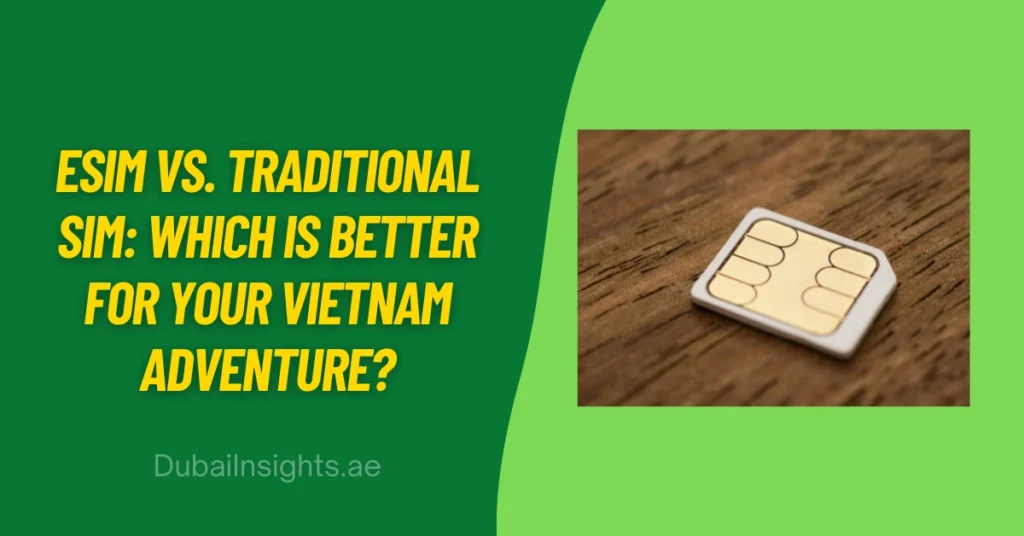eSIM vs. Traditional SIM: Which Is Better for Your Vietnam Adventure?
Planning a trip to Vietnam and stressed about staying connected? You’re not alone. Many travelers face the same dilemma: pay crazy roaming fees back home, hunt for local SIM cards at the airport, or figure out this new eSIM technology everyone’s talking about.

Whether you’re backpacking through Hanoi’s Old Quarter, working remotely from a Ho Chi Minh City cafe, or trekking through Sapa’s mountains, reliable internet isn’t just nice to have—it’s essential. From booking last-minute tours to navigating narrow alleyways and staying in touch with family, your phone connection can make or break your Vietnamese adventure.
This guide cuts through the confusion. We’ll compare eSIMs and traditional SIM cards head-to-head, so you can pick the right option for your Vietnam trip without the headaches.
Why Connectivity Matters for Your Vietnam Trip
Vietnam offers incredible diversity, from bustling cities to remote mountain villages. Each destination brings unique connectivity challenges that smart travelers prepare for in advance.
Navigating Vietnam’s Diverse Landscapes
Ho Chi Minh City and Hanoi buzz with reliable 4G networks and plenty of Wi-Fi hotspots. But venture into the terraced rice fields of Sapa or the limestone karsts of Ha Long Bay, and connectivity becomes patchy. Many travelers underestimate how much they rely on their phones until they’re standing at a rural bus stop with no signal, trying to figure out the next connection.
The language barrier adds another layer of complexity. Vietnamese uses a tonal system that makes pronunciation tricky for foreigners. Translation apps become lifelines, but they need internet to work. Even simple tasks like ordering food or asking for directions become much easier with reliable data access.
Traveler Needs: From Digital Nomads to Tourists
Vietnam attracts different types of travelers with varying connectivity needs. Digital nomads working from trendy cafes in District 1 need stable, fast internet for video calls and file uploads. Finding the best esim for vietnam becomes crucial when your income depends on staying online.
Casual tourists have different priorities. They want to share sunset photos from Hoi An, use Google Maps to find that hidden pho place, and book grab rides without hunting for Wi-Fi. Whether you’re uploading Instagram stories or video calling family back home, seamless data access transforms your travel experience from stressful to smooth.
Understanding eSIMs: The Modern Travel Solution
eSIM technology represents the latest evolution in mobile connectivity. Instead of fumbling with tiny plastic cards, you download your phone plan digitally—but how does it actually work for travelers?
What Is an eSIM and How Does It Work?
An eSIM (embedded SIM) is a tiny chip built into your phone that replaces traditional SIM cards. Think of it as a digital SIM card that you can reprogram remotely. Instead of physically swapping cards, you scan a QR code or use an app to download your new plan.
Most phones made after 2018 support eSIM technology, including iPhone XS and newer, Samsung Galaxy S20 series, and Google Pixel 3 and up. You can even store multiple eSIM profiles on one device, switching between them as needed. This means keeping your home number active while using local Vietnamese data rates.
Benefits of eSIMs for Vietnam Travel
The biggest advantage? You can activate your Vietnam data plan before your flight even takes off. No more scrambling at Tan Son Nhat Airport trying to find a SIM card vendor while exhausted from a long flight. Your phone connects to Vietnamese networks the moment you land.
Flexibility ranks as another major plus. Most eSIM providers offer plans ranging from 3-day tourist packages to 30-day digital nomad options. Need more data halfway through your trip? Top up instantly through an app rather than hunting for a physical store.
Cost savings add up quickly too. International roaming from Western carriers can cost $10-15 per day in Vietnam. Quality eSIM plans often provide the same data for a fraction of that price, especially for longer stays.
Challenges of Using eSIMs
Not every phone supports eSIM technology yet. Travelers with older devices or certain Android models might find themselves stuck with traditional options. Always check compatibility before assuming eSIM will work with your device.
The setup process, while straightforward, can intimidate less tech-savvy travelers. Unlike popping in a physical card, eSIM activation requires scanning QR codes and adjusting network settings. Most providers offer good support, but it still requires more digital confidence than traditional methods.
Traditional SIM Cards: The Classic Choice
Physical SIM cards remain the go-to choice for many Vietnam travelers. They’re familiar, widely available, and work with virtually any unlocked phone from the past decade.
How Traditional SIMs Work for Travelers
Buying a Vietnamese SIM card follows a predictable pattern. Airport vendors offer the most convenient but expensive options, while local shops in cities provide better deals with more plan variety. Major Vietnamese networks like Viettel, Mobifone, and Vinaphone maintain extensive coverage across the country.
The process typically involves showing your passport, choosing a plan, and having staff install and test the SIM card. Most tourist-focused vendors speak basic English and understand traveler needs. Popular spots include electronics markets in Ho Chi Minh City’s District 1 and Hanoi’s Old Quarter.
Advantages of Traditional SIMs
Universal compatibility tops the list of traditional SIM benefits. Any unlocked phone accepts a physical SIM card, regardless of age or model. This reliability appeals to travelers who prefer proven technology over newer alternatives.
The purchasing process feels familiar and tangible. You hand over cash, receive a physical product, and watch staff configure everything before you leave. Many travelers find this face-to-face interaction reassuring, especially when dealing with technical setup in a foreign country.
Drawbacks of Traditional SIMs
Time consumption creates the biggest headache with traditional SIMs. Airport lines stretch long during peak travel seasons, and finding quality local vendors requires research and walking around unfamiliar neighborhoods. Language barriers can complicate plan selection and troubleshooting.
Physical management adds another complication layer. Travelers must safely store their home SIM card while using the Vietnamese one, then remember to swap back before departure. Lost SIM cards mean lost contacts and potentially expensive replacement hassles back home.
Comparing eSIMs and Traditional SIMs for Vietnam
Direct comparison reveals clear winners in different categories. Understanding these trade-offs helps match the right solution to your specific travel style and needs.
Cost and Affordability
eSIM plans in Vietnam typically range from $8-15 for week-long tourist packages to $25-40 for month-long plans with generous data allowances. Traditional SIM cards cost slightly less upfront—usually $5-12 for similar data amounts—but hidden costs add up quickly.
Factor in airport markup (often 50-100% above street prices), taxi rides to find better deals, and time spent comparing options. eSIM’s transparent pricing and instant comparison shopping often provide better overall value, especially for short trips where convenience matters most.
Ease of Setup and Use
eSIM activation takes 5-10 minutes from your hotel room or even during your flight with Wi-Fi. Scan a QR code, confirm the download, and you’re connected. Tech-savvy travelers love this seamless experience, while those less comfortable with technology might prefer physical simplicity.
Traditional SIM setup involves more steps but clearer visual confirmation. You watch staff install the card, test connectivity, and explain the plan details face-to-face. Some travelers find this human interaction valuable, especially when troubleshooting problems later.
Coverage and Reliability
Both options access the same Vietnamese networks, so coverage quality remains identical. Viettel provides the broadest rural coverage, making it ideal for travelers venturing beyond major cities. Mobifone and Vinaphone offer competitive urban speeds with good international connectivity.
The key difference lies in plan flexibility. eSIM users can switch networks instantly if they encounter coverage issues, while traditional SIM users must visit physical stores to change carriers. This flexibility proves valuable when traveling from cities to remote areas with varying network strengths.
Flexibility for Different Trip Types
Short-term tourists (1-2 weeks) benefit most from eSIM convenience. Why waste precious vacation time dealing with SIM card logistics when you could be exploring Cu Chi Tunnels or relaxing in Hoi An? Quick activation and transparent pricing align perfectly with tourist priorities.
Extended travelers and digital nomads face different calculations. Longer stays make traditional SIM cards more attractive due to better local plan options and easier in-person support. Monthly unlimited plans often cost less through traditional carriers, and local shops provide better customer service for complex issues.
Simify: Your Go-To Solution for Seamless Vietnam Connectivity
When choosing an eSIM provider for Vietnam, reliability and ease of use matter more than rock-bottom prices. Simify delivers both through partnerships with Vietnam’s top networks and a user-friendly platform designed for travelers.
The service addresses every major pain point travelers face. Instant activation means no airport hassles or language barriers. Clear pricing eliminates bill shock surprises. And 24/7 support provides peace of mind when you’re halfway around the world dealing with connectivity issues.
Simify’s Vietnam plans work across all major networks, providing flexibility to switch if you encounter coverage gaps. Whether you’re video calling from a Saigon rooftop bar or uploading photos from the Mekong Delta, the service adapts to your travel patterns and data needs.
Which Option Suits Your Vietnam Adventure?
Choosing between eSIM and traditional SIM depends on your travel style, tech comfort level, and specific Vietnam itinerary. Let’s break down the best scenarios for each option.
Best for Short-Term Tourists
eSIM technology shines for Vietnam trips lasting 2 weeks or less. The instant setup saves valuable vacation time, while transparent pricing prevents bill shock. Consider a typical 10-day Vietnam highlight tour: Hanoi (3 days), Ha Long Bay (2 days), Hue (2 days), and Ho Chi Minh City (3 days).
This itinerary involves multiple domestic flights, train rides, and bus transfers. Having reliable data from the moment you land eliminates stress about finding connectivity in each new city. You can book tours, navigate unfamiliar areas, and share experiences in real-time without hunting for Wi-Fi or local SIM vendors.
Short-trip travelers also appreciate eSIM’s dual-SIM capability. Keep your home number active for important calls while using Vietnamese data rates for everything else. This setup works perfectly for business travelers who need to stay reachable but want to avoid crushing roaming charges.
Best for Long-Term Travelers or Expats
Traditional SIM cards make more sense for extended Vietnam stays. Digital nomads spending 2-3 months in Ho Chi Minh City or expats on long-term assignments benefit from local carrier relationships and in-person support options.
Vietnamese carriers offer attractive monthly unlimited plans that beat most eSIM pricing for extended use. Local shops provide personalized service, helping optimize settings for your specific device and usage patterns. This human touch becomes valuable when troubleshooting complex issues or upgrading plans.
Traditional SIMs also offer better integration with local services. Many Vietnamese apps and services work more smoothly with local phone numbers, from food delivery to ride-sharing to coworking space bookings.
Tips for Choosing Based on Your Device
Device compatibility determines your options more than personal preference. iPhone users with models XS or newer enjoy full eSIM support with easy setup processes. Samsung Galaxy S20 series and Google Pixel 3+ users also get seamless eSIM experiences.
Check your specific model’s eSIM support before assuming compatibility. Some carriers release phones with eSIM hardware disabled, while others require software updates to enable the feature. If you’re traveling with an older phone or basic smartphone, traditional SIM cards remain your only option.
Practical Tips for Staying Connected in Vietnam
Smart preparation prevents connectivity headaches once you arrive in Vietnam. Whether you choose eSIM or traditional SIM, these tips ensure smooth internet access throughout your trip.
Preparing Before You Land
Research your Vietnam itinerary’s network coverage before departure. Viettel dominates rural areas, while Mobifone and Vinaphone excel in cities. Knowing which networks work best for your planned destinations helps inform your choice.
Download essential apps before traveling: offline maps, translation tools, and currency converters. These work without internet and provide backup options when connectivity fails. Google Translate’s offline Vietnamese pack proves especially valuable for reading menus and signs.
For eSIM users, complete activation while still connected to home Wi-Fi. This ensures everything works correctly before you depend on it overseas. Test data connectivity, confirm plan details, and save customer support contacts for easy access.
Troubleshooting Connectivity Issues
Weak signals plague rural Vietnam areas regardless of your SIM choice. Dense jungle canopy around Phong Nha caves or remote mountain villages near the Chinese border challenge even the best networks. Prepare backup plans: download offline maps, carry emergency cash, and identify Wi-Fi locations in advance.
Incorrect network settings cause many traveler connectivity problems. eSIM providers usually send automatic configuration messages, but manual setup sometimes becomes necessary. Save your provider’s APN settings and customer support numbers for quick troubleshooting.
When connectivity fails completely, Vietnamese cities offer numerous internet cafes and hotel Wi-Fi as backup options. Most accommodations provide reliable internet, and coworking spaces in major cities cater specifically to digital nomads needing professional-grade connectivity.
Maximizing Data Usage
Vietnamese data plans often include generous allowances, but smart usage habits prevent overage charges and extend plan life. Download maps, music, and entertainment content over Wi-Fi before heading out for the day.
Video streaming consumes data fastest, so limit YouTube and Netflix to Wi-Fi connections. Social media apps like Instagram and TikTok also drain data quickly with auto-playing videos. Adjust settings to disable automatic video playback and high-resolution photo uploads when using mobile data.
Monitor usage through your phone’s built-in tools or your eSIM provider’s app. Most services send alerts at 75% and 90% usage, giving you time to top up or adjust habits before running out completely.
Conclusion
Both eSIMs and traditional SIM cards work well for Vietnam travel, but the best choice depends on your specific needs. Short-term tourists benefit most from eSIM’s convenience and instant setup, while long-term travelers often prefer traditional SIMs for local plan options and in-person support.
Consider your device compatibility, tech comfort level, and travel style when making this decision. Vietnam’s excellent mobile networks ensure good connectivity regardless of your choice—the key is picking the option that minimizes hassle and maximizes your time enjoying this incredible country.
For travelers seeking the perfect balance of convenience, reliability, and value, modern eSIM solutions eliminate the traditional pain points of international connectivity while providing the flexibility today’s travelers demand.
FAQs
Can I use an eSIM with any smartphone in Vietnam?
eSIM compatibility depends on your specific device model and carrier. iPhones from XS series onward support eSIM, as do most Samsung Galaxy phones from S20 and newer. Google Pixel phones starting with Pixel 3 also include eSIM capability. Check your phone’s settings under “Mobile Data” or “Cellular” to see if eSIM options appear.
Some phones have eSIM hardware but carriers disable the feature in certain regions. Contact your home carrier or check online compatibility lists to confirm support before relying on eSIM for your Vietnam trip.
Are eSIMs cheaper than traditional SIMs for Vietnam travel?
eSIM pricing varies significantly by provider and plan length. For short trips (1-2 weeks), eSIMs often cost less than roaming charges but slightly more than local traditional SIMs. The convenience factor usually justifies the small price difference for most tourists.
Longer stays tip the balance toward traditional SIMs, which offer better monthly rates and unlimited local calling. Compare total costs including setup time, airport markups, and potential roaming charges to determine the best value for your specific trip.
How reliable is eSIM coverage in Vietnam’s rural areas?
eSIM services use the same Vietnamese networks as traditional SIM cards, so coverage quality remains identical. Viettel provides the most extensive rural coverage, reaching approximately 95% of Vietnam’s population. Mobifone and Vinaphone focus more on urban areas but still cover major tourist destinations.
Remote areas like mountain regions near the Chinese border or isolated islands may have limited coverage regardless of your SIM choice. Download offline maps and prepare backup communication plans for extremely rural destinations.
Can I switch between eSIM plans during my Vietnam trip?
Most eSIM providers allow plan changes and data top-ups through their mobile apps. This flexibility helps adapt to changing travel needs—upgrade to unlimited data for a Ho Chi Minh City work week, then switch to a basic plan for rural trekking where coverage is limited.
Switching between different eSIM providers requires deleting your current profile and installing a new one. This process takes just a few minutes but temporarily disconnects your service, so plan changes carefully.
What happens if I run out of data on my eSIM in Vietnam?
Running out of data doesn’t end your connectivity options. Most eSIM providers offer instant top-up options through their apps, allowing you to purchase additional data within minutes. Simify’s user-friendly platform makes this process particularly straightforward, even when you’re stressed about losing connection.
As a backup, Vietnam’s cities offer extensive Wi-Fi coverage in hotels, restaurants, and public areas. Many cafes provide free internet to customers, giving you time to sort out data issues without completely losing connectivity during your travels.






